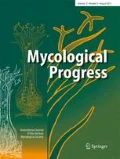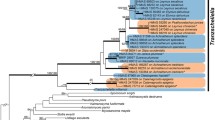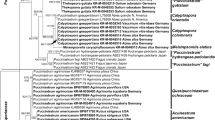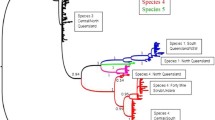Abstract
Heteroecism, or alternation between two unrelated hosts, is a widespread phenomenon among rust fungi (Pucciniales). In addition to heteroecism, rust fungi have evolved elaborate life cycles ranging from the five spore stages of macrocyclic species with many variations down to microcyclic species that may produce just two of these stages to complete their life cycles on a single host species. Considering the large number of nearly 8000 described rust fungi species and the high proportion that are host-alternating, heteroecism apparently is a successful strategy for these fungi, at least in terms of species diversity. However, the cost of maintaining a heteroecious strategy with respect to spore production and two different host plant species must be high. In Pucciniales, sister-species pairs that include one host-alternating (heteroecious) and one non-host-alternating (autoecious) species that share a common host are called correlated species. In this study, we tested Tranzschelia species for the existence of correlated species using molecular phylogenetic data. We reveal the presence of three pairs of correlated species within this single genus and suggest that this is a repeating process in the evolution of rust fungi. We show that a heteroecious macrocyclic strategy can be the starting point for deriving microcyclic autoecious species. The high cost of host alternation may be compensated by the fact that it is a facultative process in Tranzschelia with numerous strategies for the species to persist in one or the other host or as overwintering spore. Consequently, the advantage of host alternation seems higher than the cost of (facultative) heteroecism.



Similar content being viewed by others
References
Abbasi M, Aime MC (2015) Records of rust caused by Tranzschelia mexicana on black cherry (Prunus serotina) in the United States. Plant Dis 100:523
Aime MC (2006) Toward resolving family level relationships in rust fungi (Uredinales). Mycoscience 47:112–122
Aime MC, Bell CD, Wilson AW (2018) Deconstructing the evolutionary complexity between rust fungi (Pucciniales) and their plant hosts. Stud Mycol 89:143–152
Arthur JC (1906) Eine auf die Struktur und Entwicklungsgeschichte begründete Klassifikation der Uredineen. Résultats Scientifiques du Congrès International de Botanique Vienne 1905:331–348
Arthur JC (1921) New species of Uredineae – XIII. B Torrey Bot Club 48:31–42
Arthur JC (1929) The plant rusts (Urediniales). Wiley, Hoboken
Arthur JC (1934) Manual of the rusts in United States and Canada. Purdue Research Foundation, USA
Bernaux P (1956) Contribution l’étude de la biologie des Gymnosporangium. Ann Épiphyt 1:1–210
Berndt R (2012) Species richness, taxonomy and peculiarities of the neotropical rust fungi: are they more diverse in the Neotropics? Biodivers Conserv 21:2299–2322
Blomquist CL, Scholler M, Scheck HJ (2015) Detection of rust caused by Tranzschelia mexicana on Prunus salicifolia in the United States. Plant Dis 99:1856
Blumer S (1960) Untersuchungen über die Morphologie und Biologie von Tranzschelia pruni-spinosae (Pers.) Dietel und T. discolor (Fuck.) Tranz. et Litv. Phytopathol Z 38:355–388
Bruckart WL, Eskandari FM, Berner DK, Aime MC (2010) Life cycle of Puccinia acroptili on Rhaponticum (= Acroptilon) repens. Mycologia 102:62–68
Castresana J (2000) Selection of conserved blocks from multiple alignments for their use in phylogenetic analysis. Mol Biol Evol 17:540–552
Cummins GB (1959) Illustrated genera of rust fungi. Burgess Publishing Co., Minneapolis
Cummins GB (1971) The rust fungi of cereals, grasses and bamboos. Springer, New York
De Bary A (1879) Aecidium abietum. Botanische Zeitung 37:48–52 761–774, 777–789, 801–811, 825–830, 841–847
Deadman ML, Al Sadi AM, Al Maqbali YM, Al Subhi A, Al Yahya R, Aime MC (2007) First report of rust caused by Tranzschelia discolor on peach in Oman. Plant Dis 91:638
Dervis S, Dixon L, Doğanlar M, Rossman A (2010) Gall production on hawthorns caused by Gymnosporangium spp. in Hatay province, Turkey. Phytoparasitica 38(4):391–400
Dietel P (1897) Uredinales. In: Engler A, Prantl KA (eds) Die natürlichen Pflanzenfamilien. 1. Teil, Abt. 1. W. Engelmann, Leipzig, pp 24–81
Dietel P (1899) Waren die Rostpilze in früheren Zeiten plurivor? Botanisches Centralblatt 79(81–85):113–117
EPPO (2006) Gymnosporangium spp. (non-European). EPPO Bulletin 36:441–446
Farr DF, Rossman AY (2017) Fungal Databases, U.S. National Fungus Collections, ARS, USDA. Retrieved June 9, 2017, from https://nt.ars-grin.gov/fungaldatabases/
Feau N, Vialle A, Allaiere M, Maier W, Hamelin RC (2011) DNA barcoding in the rust genus Chrysomyxa and its implications for the phylogeny of the genus. Mycologia 103:1250–1266
Fischer E (1898) Entwicklungsgeschichtliche Untersuchungen über Rostpilze. Eine Vorarbeit zur monographischen Darstellung der schweizerischen Uredineen Beiträge zur Kryptogamenflora der Schweiz 1:1–121
Fisher MC, Hanage WP, de Hoog S, Johnson E, Smith MD, White NJ (2005) Low effective dispersal of asexual genotypes in heterogeneous landscapes by the endemic pathogen Penicillium marneffei. PLoS Pathog 1:e20
Gatesy J, DeSalle R, Wheeler W (1993) Alignment-ambiguous nucleotide sites and the exclusion of systematic data. Mol Phylogenet Evol 2:152–157
Giribet G, Wheeler WC (1999) On gaps. Mol Phylogenet Evol 13:132–143
Hennen JF, Buriticá P (1980) A brief summary of modern rust taxonomic and evolutionary theory. Rep Tottori Mycol Inst 18:243–256
Huelsenbeck JP, Larget B, Miller RE, Ronquist F (2002) Potential applications and pitfalls of Bayesian inference of phylogeny. Syst Biol 51:673–688
Hylander N, Joerstad I, Nannfeldt A (1953) Enumeratio Uredinearum Scandinavicarum. Opera Botanica 1:1–102
Jackson HS (1931) Present evolution tendencies and the origin of life cycles in the Uredinales. Memoirs of the Torrey Botanical Club 18:1–108
Josifovič M (1953) Le role du stade écidien dans l’évolution de Tranzschelia pruni spinosae (Pers.) Diet. Bulletin, Casse des Sciences Mathematiques et Sciences Naturelles. Academie Serbe des Sciences et des Arts 7:223–235
Katoh K, Standley DM (2013) MAFFT multiple sequence alignment software version 7: improvements in performance and usability. Mol Biol Evol 30:772–780
Kirk PM, Cannon PF, Minter DW, Stalpers JA (2008) Dictionary of the fungi, 10th edn. Cab International, Oxon
Klebahn H (1914) Uredineen. In: Dahlemer Botanischer Verein (ed) Kryptogamenflora der Mark Brandenburg, vol 5a. Bornträger, Leipzig, pp 69–946
Klenke F, Scholler M (2015) Pflanzenparasitische Kleinpilze. Bestimmungsbuch für Brand-, Rost-, Mehltau-, Flagellatenpilze und Wucherlingsverwandte in Deutschland, Österreich, der Schweiz und Südtirol. Springer-Verlag, Berlin
Leppik EE (1955) Evolution of angiosperms as mirrored in the phylogeny of rust fungi. Archivum Societatis Zoologicae Botanicae Fennicae “Vanamo” 9(suppl):159–160
López-Franco RM, Hennen JF (1990) The genus Tranzschelia (Uredinales) in the Americas. Syst Bot 15:560–591
Maier W, Begerow D, Weiß M, Oberwinkler F (2005) Phylogeny of the rust fungi: an approach using nuclear large subunit ribosomal DNA sequences. Can J Bot 81:12–23
Malloch D (1995) Fungi with heteroxenous life histories. Can J Bot 73(Suppl):S1334–S1342
McTaggart AR, Shivas RG, van der Nest MA, Roux J, Wingfield BD, Wingfield MJ (2016) Host jumps shaped the diversity of extant rust fungi (Pucciniales). New Phytol 209:1149–1158
Meinecke EP (1916) Peridermium harknesii and Cronartium quercuum. Phytopathol 6:225–240
Meinicke EP (1920) Facultative heteroecism in Peridermium cerebrum and Peridermium harknessii. Phytopathol 10:279–297
Ono Y (1994) Tranzschelia asiatica sp. nov. and its taxonomic relationship to Tranzschelia arthurii. Can J Bot 72:1178–1186
Orton LR (1927) A working hypothesis on the origin of rusts, with special reference to the phenomenon of heteroecism. Bot Gaz 84:113–138
Peterson R (1961) On “facultative heteroecism”. Phytopathol 51:266–267
Ronquist F, Teslenko M, van der Mark P, Ayres DL, Darling A, Höhna S, Larget B, Liu L, Suchard MA, Huelsenbeck JP (2012) MrBayes 3.2: efficient Bayesian phylogenetic inference and model choice across a large model space. Syst Biol 61:539–542
Roy BA, Vogler DR, Bruns TD (1998) Cryptic species in the Puccinia monoica complex. Mycologia 90:846–853
Savile DBO (1968) The rusts of Chelonae (Scrophulariaceae): a study in the co-evolution of hosts and parasites. Nova Hedwigia 15:369–392
Savile DBO (1976) Evolution of the rust fungi (Uredinales) as reflected by their ecological problems. Evol Biol 9:137–207
Scholler M, Abbasi M, Friedrich F (2014) Tranzschelia in the Americas revisited: two new species and notes on the Tranzschelia thalictri complex. Mycologia 106:448–455
Schröter J (1889) Pilze. In: Cohn F (ed) Kryptogamen-Flora von Schlesien. Dritter Band, Zweite Hälfte. JU Kern’s Verlag (Max Müller), Breslau
Shattock RC, Preece TF (2000) Tranzschel revisited: modern studies of the relatedness of different rust fungi confirm his law. Mycologist 14:113–117
Stamatakis A (2014) RAxML version 8: a tool for phylogenetic analysis and post-analysis of large phylogenies. Bioinformatics 30:1312–1313
Tranzschel W (1904) Über die Möglichkeit die Biologie wirtswechselnder Rostpilze auf Grund morphologischer Merkmale vorauszusehen. Arbeiten der Kaiserlichen St. Petersburger Naturforschenden Gesellschaft 35:311–313
Urban Z, Markova J (2009) Catalogue of rust fungi of the Czech and Slovak Republics. Karolinum Press, Charles University, Prague
Vilgalys R, Hester M (1990) Rapid genetic identification and mapping of enzymatically amplified ribosomal DNA from several Cryptococcus species. J Bacteriol 172:4238–4246
Vogler DR, Bruns TD (1998) Phylogenetic relationships among the pine stem rust fungi (Cronartium and Peridermium spp.). Mycologia 90:244–257
Wilson M, Henderson DM (1966) British rust fungi. University Press, Cambridge
Zambino PJ, Szabo LJ (1993) Phylogenetic relationships of selected cereal and grass rusts based on rDNA sequence analysis. Mycologia 85:401–414
Zwetko P (1990) Rostpilze (Uredinales) auf Carex im Ostalpenraum. Ein neues Artenkonzept. Bibliotheca Mycologica 153:1–222
Acknowledgements
We thank the curators of the public herbaria DAOM, GLM, IRAN, MIN and PUR and collectors (listed in Table 1) for providing specimens for this study.
Funding
Molecular work was supported by the National Science Foundation Assembling the Tree of Life project (NSF DEB 0732968 to D. Hibbett and MCA), the Louisiana Board of Regents (MCA) and the German Barcode of Life (GBOL) project, supported by the German Federal Ministry of Education and Research (BMBF FKZ 01LI1501l to MS).
Author information
Authors and Affiliations
Corresponding author
Additional information
Section Editor: Meike Piepenbring
This article is part of the “Special Issue on hyphomycete taxonomy and diversity in honour of Walter Gams who passed away in April 2017.”
Rights and permissions
About this article
Cite this article
Scholler, M., Lutz, M. & Aime, M.C. Repeated formation of correlated species in Tranzschelia (Pucciniales). Mycol Progress 18, 295–303 (2019). https://doi.org/10.1007/s11557-018-1417-2
Received:
Revised:
Accepted:
Published:
Issue Date:
DOI: https://doi.org/10.1007/s11557-018-1417-2




